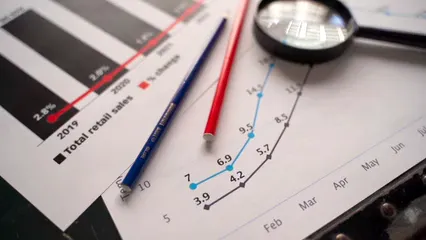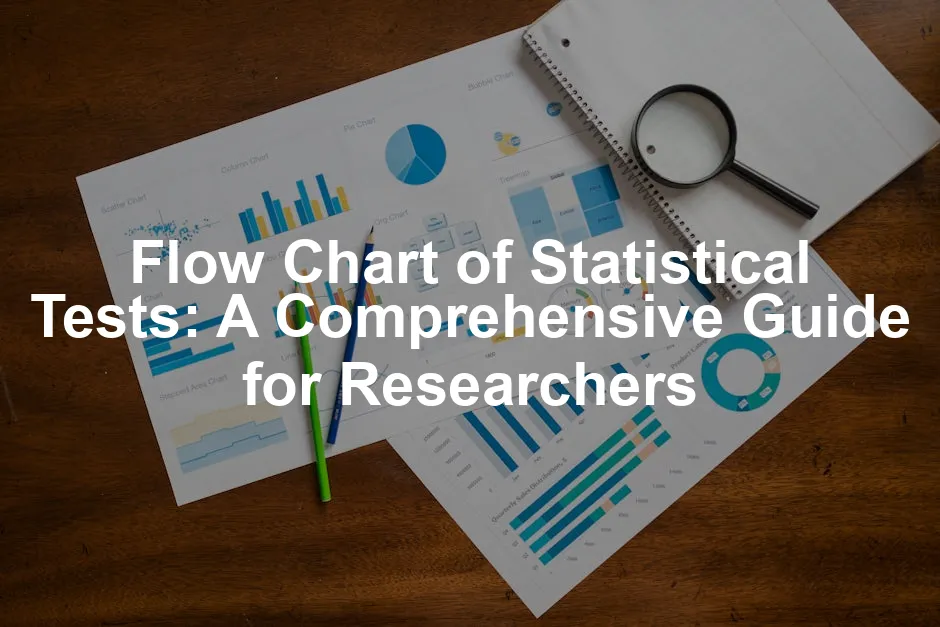Introduction
Selecting the right statistical test is crucial for any research study. Choose incorrectly, and you risk invalid conclusions. The myriad of options can be overwhelming. Fear not! Flow charts are here to rescue you from the statistical maze.
Flow charts help simplify complex decision-making processes. They guide researchers step-by-step, ensuring you don’t end up comparing apples to oranges. By following a logical path, you can easily pinpoint which test suits your data best.
This article aims to be your trusty companion. We’ll provide a detailed guide on using a flow chart to choose statistical tests effectively. No more second-guessing! With this knowledge, you’ll confidently tackle your research inquiries. Get ready to say goodbye to statistical stress!

Understanding Statistical Tests
What is a Statistical Test?
Statistical tests are tools researchers use to make sense of their data. They help determine if the patterns observed are real or just random chance. Essentially, these tests evaluate hypotheses, often structured as a null hypothesis. The null hypothesis typically posits no effect or no difference between groups.
Once the data is gathered, researchers apply a statistical test to assess validity. This involves calculating a test statistic, which measures the deviation of the observed data from what the null hypothesis predicts. The magic happens next with p-values! These values indicate the probability of observing the data if the null hypothesis were true. A low p-value (commonly below 0.05) suggests that the null hypothesis may be rejected, leading to the acceptance of an alternative hypothesis.
Types of Statistical Tests
Statistical tests can be broadly classified into two categories: parametric and non-parametric.
Parametric tests assume that the data follows a specific distribution and meet certain criteria. Examples include the t-test, ANOVA, and regression analysis. Use them when your data is normally distributed and meets other assumptions.
On the flip side, non-parametric tests do not rely on these strict assumptions. They are perfect for data that doesn’t fit a normal distribution or when dealing with ordinal data. Common examples are the Mann-Whitney U test and the Kruskal-Wallis test.
When selecting a test, consider the nature of your data. Are your variables quantitative (e.g., height, weight) or categorical (e.g., gender, species)? Understanding this distinction is essential for accurate results.
Speaking of understanding your data, if you want a comprehensive introduction to statistics, grab your copy of Statistics for Dummies. This book is perfect for demystifying the world of stats!

Key Considerations When Choosing a Test
Before you jump into selecting a statistical test, consider a few key factors. First, identify your data types. Quantitative data can be further classified into continuous and discrete. Qualitative data can be nominal or ordinal.
Next, you must meet the assumptions required for your chosen test. Common assumptions include normality, homogeneity of variances, and independence of observations. For instance, many parametric tests, like the t-test, require normally distributed data. If your data violates these assumptions, consider opting for a non-parametric test instead.
In summary, understanding your data types and assumptions is vital. It sets the foundation for selecting the appropriate statistical test, ensuring your results are reliable and valid. With this knowledge, you’re well on your way to mastering the art of statistical analysis.
If you’re looking to dive deeper into data analysis, consider picking up Python for Data Analysis by Wes McKinney. This book is a fantastic resource for anyone looking to analyze data with Python!

The Flow Chart of Statistical Tests
Overview of the Flow Chart
The flow chart of statistical tests is a visual guide that simplifies the decision-making process in selecting the right statistical test. Picture it as a roadmap for researchers, filled with questions that lead you to the best test based on your data’s characteristics.
At the top, you start by identifying your variables. Is your independent variable categorical, like “yes” or “no,” or continuous, like height or weight? As you make your way down the chart, you’ll encounter branches that further refine your choices—considerations of dependent variables, the number of groups, and the specific assumptions required for different tests.
This chart is invaluable for researchers. It helps you avoid the pitfalls of choosing the wrong test. Think of it as your statistical GPS, guiding you through a forest of options and helping you arrive at the right destination—valid conclusions!
And if you’re looking for an excellent resource to help you create your own flowcharts, check out Flowchart Templates for Statistical Tests. These templates can save you time and streamline your analysis!

Step-by-Step Breakdown of the Flow Chart
1. Identify the Type of Variables
First up, let’s get to know your independent and dependent variables.
– Independent Variables: These are the variables you manipulate or categorize. They can be either:
– Categorical: Think of categories like “male” or “female,” or “treatment” versus “control.”
– Continuous: These are measurable quantities like temperature or time.
– Dependent Variables: These are your outcomes, the variables you measure. They come in several flavors:
– Nominal: Simple categories without order, like “favorite ice cream flavor.”
– Ordinal: Categories with a clear order, such as a satisfaction scale from “very unsatisfied” to “very satisfied.”
– Interval: Numeric scales where the difference between values is meaningful, like temperature in Celsius.
– Ratio: Similar to interval but with a true zero point, such as weight or height.
Providing these examples helps clarify why knowing your variables matters. It’s like choosing the right tool for the job—screwdrivers for screws, hammers for nails!

2. Determine the Number of Groups
Next, assess how many groups you’re working with. This factor can significantly influence your test choice.
– Two Groups: If you’re comparing just two groups, you might opt for tests like the independent t-test for parametric data or the Mann-Whitney U test for non-parametric data. Think of a classic study comparing test scores between students who study with music versus those who study in silence.
– More Than Two Groups: When you have three or more groups, the options expand. You could use a one-way ANOVA for parametric data or the Kruskal-Wallis test for non-parametric data. Imagine comparing the effectiveness of three different teaching methods on student performance.
Understanding the number of groups helps narrow down your testing options. It’s like deciding how many players you need for a game—two for tennis, but more for a soccer match!
For a more comprehensive understanding, consider Statistical Analysis with R: A Comprehensive Guide. It’s a great resource for those looking to expand their analytical toolbox!

3. Assess the Assumptions
When selecting a statistical test, you must consider the assumptions behind each type. Parametric tests, like t-tests and ANOVAs, come with specific requirements. They assume your data follows a normal distribution. You also need to ensure there’s homogeneity of variances across groups. If your data is like a party with everyone mingling, these tests are your VIP pass!
But what happens if your data doesn’t fit the bill? If normality is a no-show, don’t panic! Non-parametric tests are here to save the day. These tests, such as the Mann-Whitney U test and Kruskal-Wallis test, don’t rely on strict assumptions. They’re perfect for skewed data or ordinal variables. So, when in doubt, embrace the non-parametric route!
For those who prefer a more visual approach, consider using a Graphing Calculator to help visualize your data and understand its distribution better!

4. Choosing the Appropriate Test
Now that you’ve assessed your assumptions, it’s time to pick a test. The flow chart helps you navigate this process effortlessly. Here’s a quick rundown of common statistical tests based on the pathways you might encounter:
– Independent t-test: Ideal for comparing two independent groups. Learn more about the t-test here.
– Mann-Whitney U test: The non-parametric alternative for the independent t-test. Discover the details here.
– ANOVA: When you have three or more groups to compare, ANOVA is your go-to. Find out more about ANOVA here.
– Kruskal-Wallis test: The non-parametric counterpart to ANOVA. Check it out here.
– Pearson correlation: Use this to examine relationships between two continuous variables. Read more about Pearson correlation here.
– Spearman’s rank correlation: A non-parametric alternative for assessing relationships. Learn about it here.
By following the flow chart, you can pinpoint the right test for your research, ensuring you don’t end up with a statistical faux pas. Happy testing!

Tips for Effective Use of the Flow Chart
Navigating the flow chart of statistical tests can feel like wandering through a maze. Fear not! Here are some practical tips to guide you through efficiently.
First, always start at the top. Identify your variables clearly. Are they categorical or continuous? This distinction helps you move down the chart accurately.
Next, don’t skip any steps. Each question in the flow chart narrows down your options. Missing a step might lead you to the wrong test.
Beware of common pitfalls! One major mistake is overlooking the assumptions tied to each test. Ensure your data meets these requirements. For instance, if you’re using a t-test, confirm that your data is normally distributed.
Lastly, don’t hesitate to consult additional resources if you’re stuck. There are numerous articles and tools available to assist you. Remember, the goal is to find the best statistical test for your data, not to rush through the process.
For a more structured approach, consider using Statistical Analysis with Excel. This resource can help you visualize and analyze your data effectively!

Additional Resources
Interactive Tools and Software
When it comes to statistical analysis, having the right tools is essential. Several software options can assist you in navigating the complexities of statistical tests.
R is a powerful programming language renowned for its statistical capabilities. With a vast array of packages, R can handle everything from basic tests to advanced modeling. It’s free and has a supportive online community.
SPSS is another popular choice. Its user-friendly interface makes it accessible for beginners. SPSS offers built-in functions for a variety of statistical tests, streamlining the analysis process.
For those who prefer coding, Python libraries like SciPy and Statsmodels are fantastic resources. These libraries provide functions for conducting numerous statistical tests and analyses.
Additionally, online interactive flowchart tools can enhance your decision-making process. Websites like StatsFlowchart offer interactive decision trees that guide you through the selection of statistical tests based on your data type.
And for a solid understanding of data science principles, don’t miss out on Data Science for Business. This book is a great resource for understanding how data analytics can drive business decisions.

Further Reading
If you’re eager to deepen your understanding of statistical methods, numerous resources are available.
– “Practical Statistics for Data Scientists” by Peter Bruce and Andrew Bruce: This book offers a solid foundation in statistical concepts tailored for data analysis. Grab it here!
– “The Art of Statistics: Learning from Data” by David Spiegelhalter: Spiegelhalter provides insights into interpreting data and making sensible decisions based on statistical evidence. Check it out here!
– Online Articles: Websites like Scribbr and Stats and R feature extensive articles on choosing the right statistical tests and understanding their applications.
– Video Tutorials: Platforms like YouTube have a wealth of tutorials on statistical tests. Channels dedicated to statistics and data science can provide visual learners with valuable perspectives.
By utilizing these tools and resources, you’ll be well-equipped to select the appropriate statistical tests for your research. Remember, a solid understanding of statistical methods enhances the validity of your conclusions. Don’t hesitate to explore these further!

Conclusion
In wrapping up our exploration of the flow chart of statistical tests, let’s recap the essential points. Choosing the right statistical test is paramount for any research endeavor. Whether you’re testing a new drug, analyzing survey results, or comparing teaching methods, the correct test ensures that your findings are valid and reliable.
The journey begins with understanding your data. Are your variables categorical or continuous? This fundamental distinction shapes your choice of test. The flow chart simplifies this process, guiding you through a series of logical steps. It encourages you to ask the right questions about your data and its characteristics.
Remember, assumptions play a crucial role in statistical testing. Many parametric tests require specific conditions to be met, such as normality and homogeneity of variance. If these assumptions are violated, non-parametric alternatives can save the day! The flow chart helps you navigate these complexities effortlessly, ensuring you’re well-equipped to make informed decisions.
So, how can you apply this knowledge in your research? By utilizing the flow chart as a practical tool, you can streamline your statistical analysis process. It acts as your trusty guide, helping you avoid the pitfalls of misapplication and leading you to the correct tests for valid conclusions.
As you embark on your statistical adventures, keep this flow chart close at hand. It’s not just a tool; it’s your ally in making sense of data and drawing meaningful insights. Embrace the power of statistical testing, and let the flow chart illuminate your path to success!

FAQs
What is the difference between parametric and non-parametric tests?
Parametric tests assume data follows a specific distribution, like a normal distribution. They are typically more powerful if the assumptions are met. Non-parametric tests do not rely on these assumptions, making them suitable for skewed data or ordinal variables. They are often less powerful but provide flexibility when data conditions are unclear.
How can I determine if my data meets the assumptions for a specific test?
To check if your data meets the assumptions, you can perform several tests. For normality, the Shapiro-Wilk test or visual inspections like Q-Q plots can help. For homogeneity of variances, Levene’s test is effective. Always visualize your data through histograms or box plots to assess these conditions before proceeding with your analysis.
What are some common statistical tests for comparing means?
Common tests include the independent t-test for comparing two means, one-way ANOVA for three or more means, and the Mann-Whitney U test for non-parametric comparisons. Each test has specific conditions, so ensure your data aligns with these requirements before applying them.
When should I use a correlation test instead of a regression analysis?
Use correlation tests when you want to assess the strength and direction of a relationship between two variables, without implying causation. Regression analysis, on the other hand, is used when you want to predict the value of a dependent variable based on one or more independent variables. Essentially, correlation is for association, while regression is for prediction.
How do I interpret the results of a statistical test?
Start with the p-value. A value less than 0.05 typically indicates statistical significance, meaning the results are unlikely to have occurred by chance. Also, look at confidence intervals to gauge the precision of your estimates. Finally, consider effect size to understand the practical significance of your findings, not just their statistical significance.
Please let us know what you think about our content by leaving a comment down below!
Thank you for reading till here 🙂
For a comprehensive guide on the flow chart for statistical tests, visit this resource.
All images from Pexels




